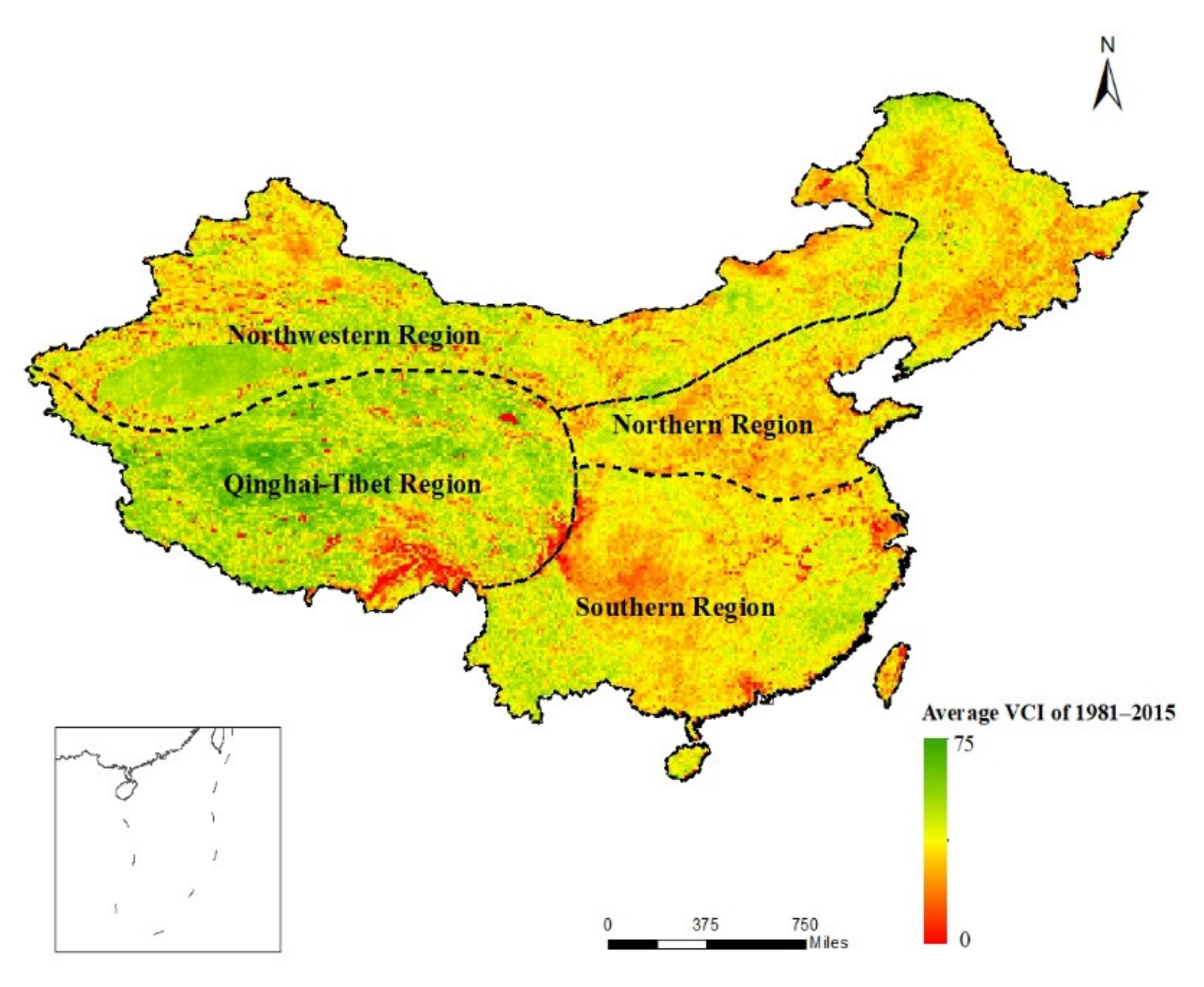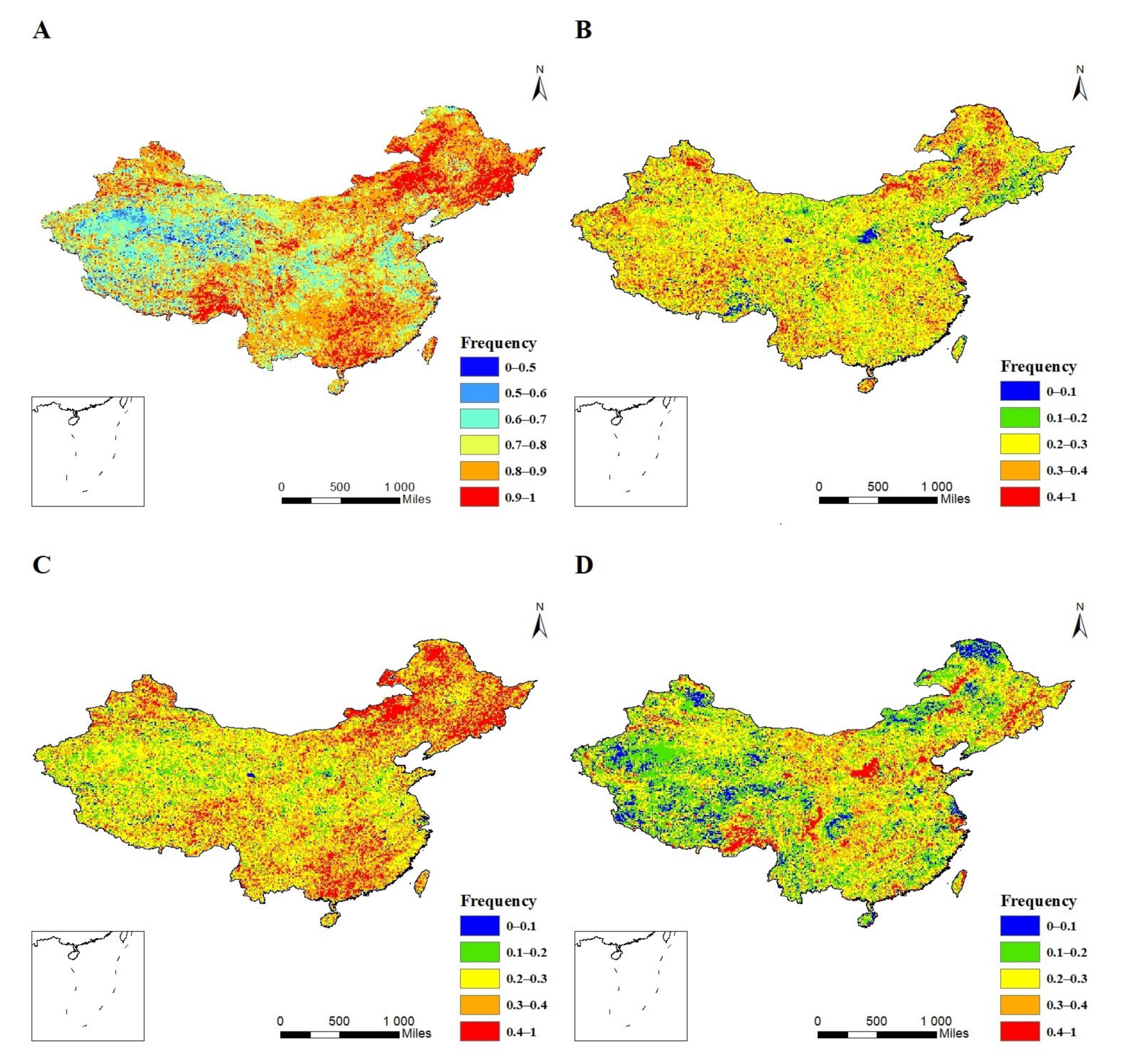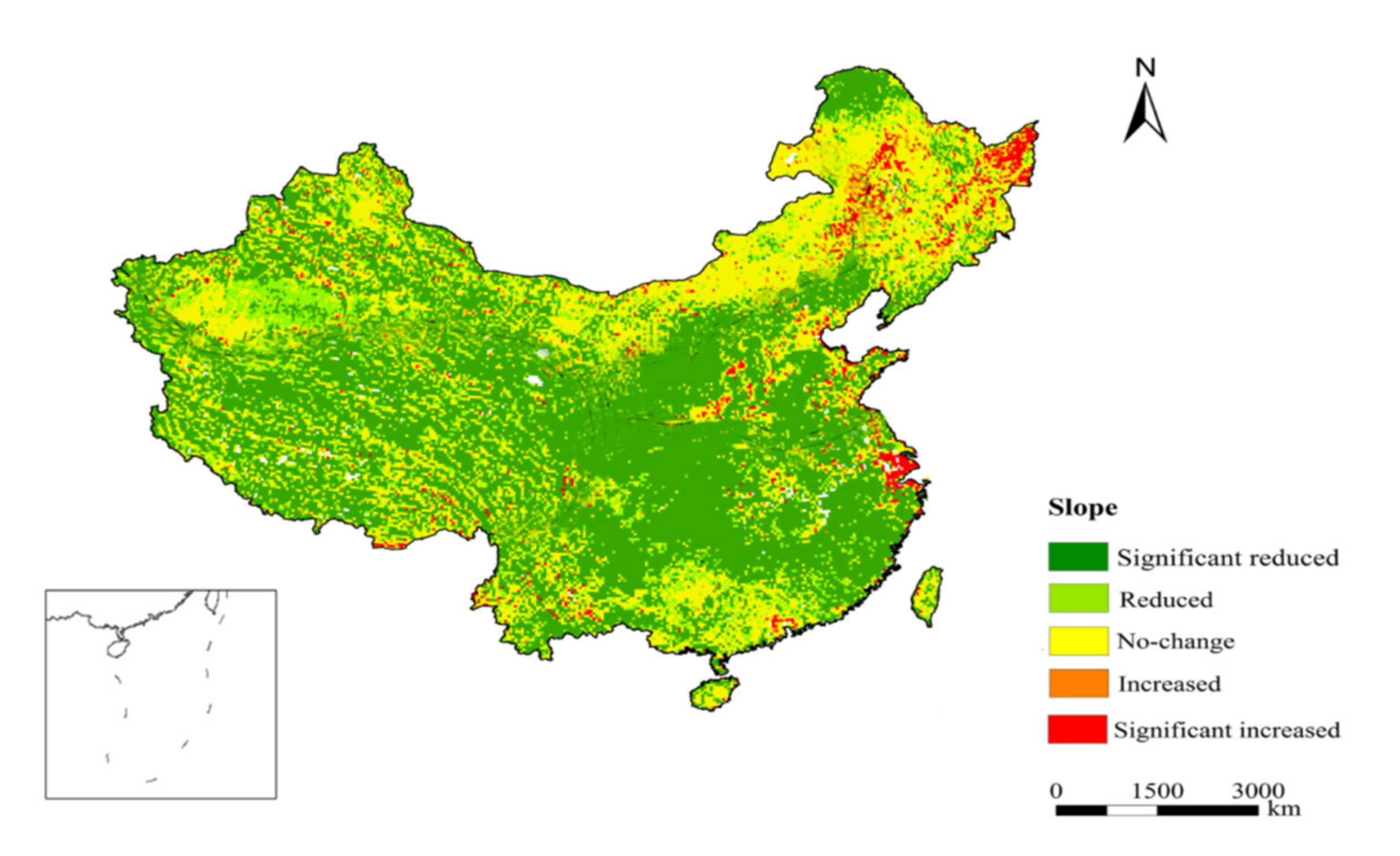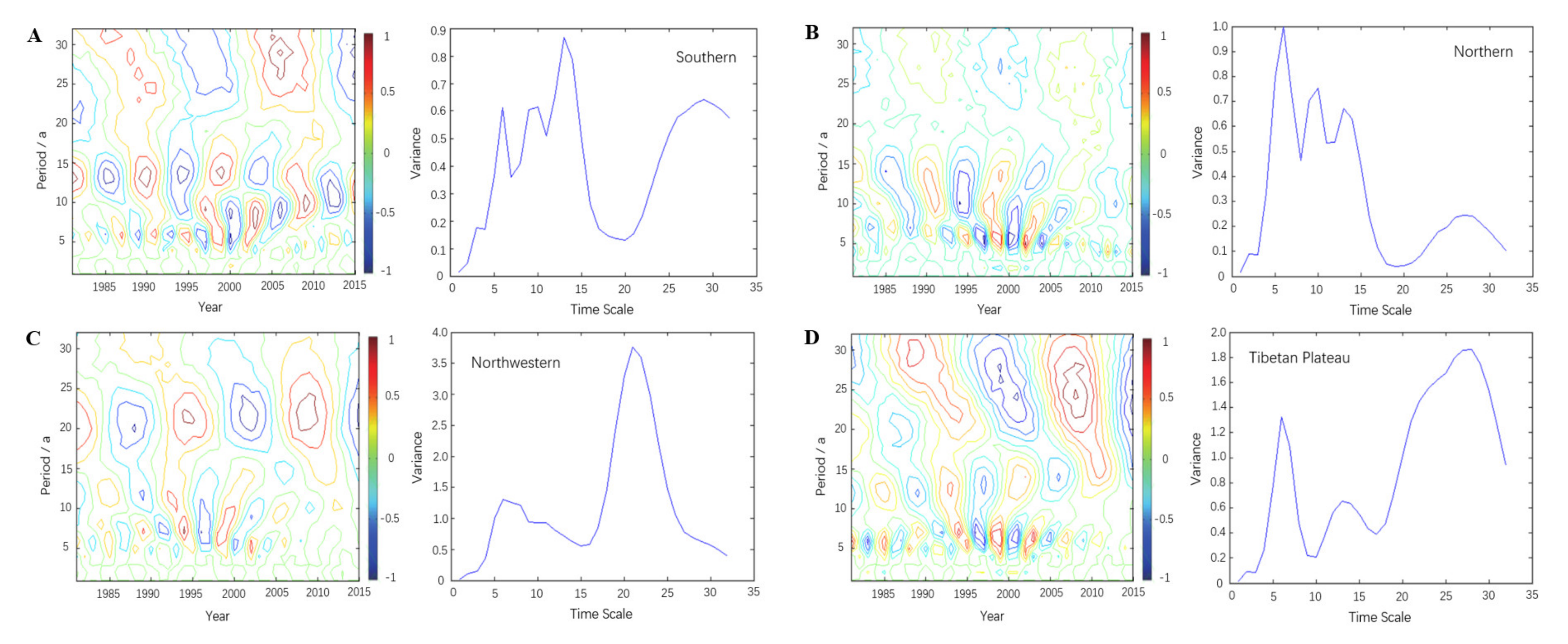VCI-Based Analysis on Spatiotemporal Variations of Spring Drought in China
Abstract
:1. Introduction
2. Study Area and Data
2.1. Study Area
2.2. Research Data
3. Research Methods
3.1. Calculation of Drought Frequency
3.2. VCI Trend Analysis
3.3. Calculation of the Anomaly VCI
3.4. Mutation Test for the VCI
3.5. Wavelet Analysis of the VCI
4. Results and Analysis
4.1. Drought Frequencies in China
4.2. Analysis of Drought Trend in China
4.3. Analysis of Temporal Drought Characteristics in Different Geographical Regions
4.4. Mutation Analysis of VCI Time Series in Different Geographical Regions
4.5. Wavelet Analysis of the VCI in Different Geographical Regions
5. Discussion
6. Conclusions
- China has a high frequency of spring drought but mainly suffers from slight and moderate drought. Moreover, there are obvious regional differences in spring drought. The frequency of spring drought is higher in the southern and northern regions, which are more affected by the monsoon; except for northern Xinjiang and southern Tibet, the frequency of drought is relatively low in the northwestern and Qinghai-Tibet regions, which are less affected by the monsoon.
- During 1981–2015, the spring VCI in all parts of China showed an overall upward trend; that is, the spring drought in most regions tended to ease. Temporal analysis showed that the trend was not a single change but a wavy growth trend, which can be divided into the stage of slow growth from 1981–1990, the stage of sharp fluctuations from 1991–2000, the stage of steady growth from 2001–2010 and the stage of slow decline after 2010.
- The Mann–Kendall test further indicated that since the 1990s, the change in the VCI series was an actual upward trend instead of a random fluctuation, and the changes in the southern, northwestern and Qinghai-Tibet regions reached a significant level. Among them, the time point of mutation in the southern region was 2000, and in the northwestern and Qinghai-Tibet regions, it was 1992.
- There are short-period oscillations of approximately 5–7 years and long-period oscillations of approximately 23–28 years in China and its four geographical regions. Among them, the northwestern and Qinghai-Tibet regions, which are less affected by the monsoon, are dominated by long-term oscillations, while the southern and northern areas, which are more affected by the monsoon, are dominated by short-term oscillations. All regions have approximately seven obvious alternations of drought and humidity on the short-cycle scale and two obvious alternations of drought and humidity on the long-cycle scale. In addition, all regions are in a small humid period within a large partial drought cycle.
Author Contributions
Funding
Institutional Review Board Statement
Informed Consent Statement
Data Availability Statement
Acknowledgments
Conflicts of Interest
References
- Gu, Y.; Ni, S.H.; Lin, J. China’s drought disaster situation changes and distribution characteristics. China Water Resour. 2011, 13, 27–30. [Google Scholar]
- Ma, S.Q.; Wang, Q.; Yu, H.; Xu, L.P.; Zhang, T.L. Field experiment study into influence of spring drought on maize yield. J. Nat. Disasters 2012, 21, 207–212. [Google Scholar]
- Chen, S.Y.; He, H.M.; Wu, F.R.; Li, C.D. Climate change characteristics of the spring drought in southwest-south China. J. Arid Land Resour. Environ. 2015, 29, 138–143. [Google Scholar]
- Cao, Y.Q.; Zheng, S.; Fan, S.B.; Guo, M. Evolution analysis of spring drought events in Northwest Liaoning based on grade adjustment of Z-Index. Arid Land Geogr. 2017, 40, 10–16. [Google Scholar]
- Yu, F.Y.; Jin, L.Y.; Li, J.J. Characteristics of Spring Drought in Southwest China and the Anomalous Circulation. Desert Oasis Meteorol. 2020, 14, 68–76. [Google Scholar]
- Raziei, T.; Bordi, I.; Pereira, L.S. Regional drought Modes in Iran using the SPI: The effect of Time scale and spatial resolution. Water Resour. Manag. 2013, 27, 1661–1674. [Google Scholar] [CrossRef]
- Hao, Y.; Wang, S.Q.; Wang, J.B.; Lu, H.Q.; Guo, A.H.; Zhu, Z.C. Assessing spatiotemporal variation of drought in China and its impact on agriculture during 1982–2011 by using PDSI indices and agriculture drought survey data. J. Geophys. Res. 2016, 121, 2283–2298. [Google Scholar]
- Wei, J.; Ma, G.Z. Comparison of Palmer Drought Severity Index, percentage of precipitation anomaly and surface humid index. Acta Geogr. Sin. 2003, 58, 117–124. [Google Scholar]
- Feng, Q.; Tian, G.L.; Wang, A.S.; McVicar, T.R.; Jupp, D.L.B. Remote sensing monitoring of soil humidity using vegetation condition index. J. Nat. Disasters 2004, 3, 81–88. [Google Scholar]
- Li, Z.; Zhou, T.; Zhao, X. Diverse spatial-temporal responses in vegetation growth to droughts in China. Environ. Earth Sci. 2016, 75, 1–13. [Google Scholar]
- Guo, N.; Guan, X.D. An improvement of the vegetation condition index with applications to the drought monitoring in Northwest China. Adv. Earth Sci. 2007, 22, 1160–1168. [Google Scholar]
- Mirabbasi, R.; Anagnostou, E.N.; Fakheri-Fard, A.; Dinpashoh, Y.; Eslamian, S. Analysis of meteorological drought in northwest Iran using the joint deficit index. J. Hydrol. 2013, 492, 35–48. [Google Scholar] [CrossRef]
- Mendicino, G.; Senatore, A.; Versace, P. A groundwater resources index (GRI) for drought monitoring and forecasting in a Mediterranean climate. J. Hydrol. 2008, 357, 282–302. [Google Scholar] [CrossRef]
- Rouse, J., Jr.; Haas, R.H.; Schell, J.A. Monitoring vegetation systems in the Great Plains with ERTS. NASA Spec. Publ. 1974, 351, 309. [Google Scholar]
- Liang, L.; Zhao, S.; Qin, Z.; He, K.; Chen, C.; Luo, Y. Drought change trend using MODIS TVDI and its relationship with climate factors in China from 2001 to 2010. J. Integr. Agric. 2014, 13, 1501–1508. [Google Scholar] [CrossRef]
- Sandholt, I.; Rasmussen, K.; Andersen, J. A simple interpretation of the surface temperature/vegetation index space for assessment of surface moisture status. Remote Sens. Environ. 2001, 79, 213–224. [Google Scholar] [CrossRef]
- Kogan, F.N. Remote sensing of weather impacts on vegetation in non-homogeneous areas. Int. J. Remote Sens. 1990, 11, 1405–1419. [Google Scholar] [CrossRef]
- Kogan, F.N. Droughts of the late 1980s in the United States as derived from NOAA polar-orbiting satellite data. Bull. Amer. Meteor. Soc. 1995, 76, 655–668. [Google Scholar] [CrossRef] [Green Version]
- Liu, W.T.; Kogan, F.N. Monitoring regional drought using the Vegetation Condition Index. Int. J. Remote Sens. 1996, 17, 2761–2782. [Google Scholar] [CrossRef]
- Deng, M.; Di, L.; Han, W.; Yagci, A.; Peng, C.; Heo, G. Web-service-based Monitoring and Analysis of Global Agricultural Drought. Photogramm. Eng. Remote Sens. PERS 2013, 79, 929–943. [Google Scholar] [CrossRef]
- Qian, X.; Liang, L.; Shen, Q.; Sun, Q.; Zhang, L.; Liu, Z.; Zhao, S.; Qin, Z. Drought trends based on the VCI and its correlation with climate factors in the agricultural areas of China from 1982 to 2010. Environ. Monit. Assess. 2016, 188, 639. [Google Scholar] [CrossRef]
- Shen, Q.; Liang, L.; Luo, X.; Li, Y.; Zhang, L. Analysis of the spatial-temporal variation characteristics of vegetative drought and its relationship with meteorological factors in China from 1982 to 2010. Environ. Monit. Assess. 2017, 189, 471. [Google Scholar] [CrossRef]
- Guan, X.D.; Guo, N.; Huang, J.P.; Ge, J.P.; Zheng, Z.H. Applicability analysis of VCI to monitoring northwest China drought. Plateau Meteorol. 2008, 27, 1046–1053. [Google Scholar]
- Yan, Y.; Xiao, F.; Du, Y.; Ling, F.; Li, X.D.; Li, Y.Z. Monitoring droughts in the five provinces along the middle-lower reaches of the Yangtze River during spring/summer 2011 using AVCI. Resour. Environ. Yangtze Basin 2012, 21, 1154–1159. [Google Scholar]
- Ji, M.; Zhang, C.; Zhao, J.W.; Yan, J.; Liang, L. Temporal and spatial dynamics of spring drought in Qinghai-Tibet region based on VCI index. Remote Sens. Land Resour. 2021, 33, 152–157. [Google Scholar]
- Feng, Q.; Tian, G.L.; Liu, Q.H. Research on the operational system of drought monitoring by remote sensing in China. J. Remote Sens. 2003, 7, 14–18. [Google Scholar]
- Han, Y.F. China Regional Geography; Guangdong Higher Education Press: Guangzhou, China, 2000; pp. 113–116. [Google Scholar]
- Zhao, J.; Chen, C.K. China’s Geography; Higher Education Press: Beijing, China, 2011; pp. 361–364. [Google Scholar]
- Chen, L.; Ford, T.W.; Yadav, P. The Role of Vegetation in Flash Drought Occurrence: A Sensitivity Study Using Community Earth System Model, Version 2. J. Hydrometeorol. 2021, 22, 845–857. [Google Scholar] [CrossRef]
- Liang, L.; Sun, Q.; Luo, X.; Wang, J.; Zhang, L.; Deng, M.; Di, L.; Liu, Z. Long-term spatial and temporal variations of vegetative drought based on vegetation condition index in China. Ecosphere 2017, 8, e0191. [Google Scholar] [CrossRef]
- Zhang, Y.D.; Zhang, X.H.; Liu, S.R. Correlation analysis on normalized difference vegetation index (NDVI) of different vegetations and climatic factors in Southwest China. Chin. J. Appl. Ecol. 2011, 22, 323–330. [Google Scholar]
- Wei, F.Y. Statistical Diagnosis and Prediction Technology of Modern Climate; China Meteorological Press: Beijing, China, 1999. [Google Scholar]
- Liu, M.C. Wavelet Analysis and Its Application, 2nd ed.; Tsinghua University Press: Beijing, China, 2013; pp. 22–34. [Google Scholar]
- Torrence, C.; Compo, G.P. A practical guide to wavelet analysis. Bull. Am. Meteorol. Soc. 1998, 79, 61–78. [Google Scholar] [CrossRef] [Green Version]
- Liu, Y.; Xu, G.; Yin, Z.; Hu, C.; Wang, Y.; Liao, F. Spatio-temporal change of surface air temperature in Anhui province in the context of global warming from 1960 to 2014. J. Nat. Resour. 2017, 32, 680–691. [Google Scholar]
- Li, M.; Wang, G.W.; Chai, X.R.; Hu, W.X.; Zhang, L.Z. Spatial clustering based climatic zoning and drought time variation characteristics in northeast China. J. Nat. Resour. 2019, 34, 1682–1693. [Google Scholar]
- Lara, C.; Saldías, G.S.; Paredes, A.L.; Cazelles, B.; Broitman, B.R. Temporal Variability of MODIS Phenological Indices in the Temperate Rainforest of Northern Patagonia. Remote Sens. 2018, 10, 956. [Google Scholar] [CrossRef] [Green Version]
- Zhang, Q.; Tang, H.P.; Cui, F.Q.; Dai, L.W. Based on the variation characteristics of the hulun buir grassland drought SPEI and trend analysis. Acta Ecol. Sin. 2019, 19, 1–14. [Google Scholar]
- Dai, A. Characteristics and trends in various forms of the Palmer Drought Severity Index during 1900–2008. J. Geophys. Res. 2011, 116, 1248–1256. [Google Scholar] [CrossRef] [Green Version]
- Suping, W.; Cunjie, Z.; Yaohui, L.; Jianying, F.; Jinsong, W. Analysis of mult-timescale drought variation based on standardized precipitation index in China during 1960–2011. J. Desert Res. 2014, 34, 827–834. [Google Scholar]
- Wang, Z.; Li, J.; Huang, Z.; Zhong, R.; Chen, J.; Qiu, Z. Spatiotemporal variations analysis of meteorological drought in China based on scPDSI. Trans. Chin. Soc. Agric. Eng. 2016, 32, 161–168. [Google Scholar]
- Zhang, J.; Shen, Y.J. Spatio-temporal variations in extreme drought in China during 1961–2015. J. Geogr. Sci. 2019, 29, 67–83. [Google Scholar] [CrossRef] [Green Version]
- Polanco-Martínez, M.; Fernández-Macho, J.; Medina-Elizalde, M. Dynamic wavelet correlation analysis for multivariate climate time series. Sci. Rep. 2020, 10, 21277. [Google Scholar] [CrossRef] [PubMed]
- Anshuka, A.; Buzacott, A.J.; Vervoort, R.W.; van Ogtrop, F.F. Developing Drought Index Based Forecasts for Tropical Climates using Wavelet Neural Network: An Application in Fiji. Theor. Appl. Climatol. 2021, 143, 1–2. [Google Scholar] [CrossRef]







| Slope of Average VCI | F-Test Value | Change Level of VCI |
|---|---|---|
| slope > 0 | F ≥ 7.56 | Extremely significant increase |
| 4.14 ≤ F < 7.56 | Significant increase | |
| F < 4.14 | No significant increase | |
| slope < 0 | F < 4.14 | No significant decrease |
| 4.14 ≤ F < 7.56 | Significant decrease | |
| F ≥ 7.56 | Extremely significant decrease |
Publisher’s Note: MDPI stays neutral with regard to jurisdictional claims in published maps and institutional affiliations. |
© 2021 by the authors. Licensee MDPI, Basel, Switzerland. This article is an open access article distributed under the terms and conditions of the Creative Commons Attribution (CC BY) license (https://creativecommons.org/licenses/by/4.0/).
Share and Cite
Liang, L.; Qiu, S.; Yan, J.; Shi, Y.; Geng, D. VCI-Based Analysis on Spatiotemporal Variations of Spring Drought in China. Int. J. Environ. Res. Public Health 2021, 18, 7967. https://doi.org/10.3390/ijerph18157967
Liang L, Qiu S, Yan J, Shi Y, Geng D. VCI-Based Analysis on Spatiotemporal Variations of Spring Drought in China. International Journal of Environmental Research and Public Health. 2021; 18(15):7967. https://doi.org/10.3390/ijerph18157967
Chicago/Turabian StyleLiang, Liang, Siyi Qiu, Juan Yan, Yanyan Shi, and Di Geng. 2021. "VCI-Based Analysis on Spatiotemporal Variations of Spring Drought in China" International Journal of Environmental Research and Public Health 18, no. 15: 7967. https://doi.org/10.3390/ijerph18157967
APA StyleLiang, L., Qiu, S., Yan, J., Shi, Y., & Geng, D. (2021). VCI-Based Analysis on Spatiotemporal Variations of Spring Drought in China. International Journal of Environmental Research and Public Health, 18(15), 7967. https://doi.org/10.3390/ijerph18157967






